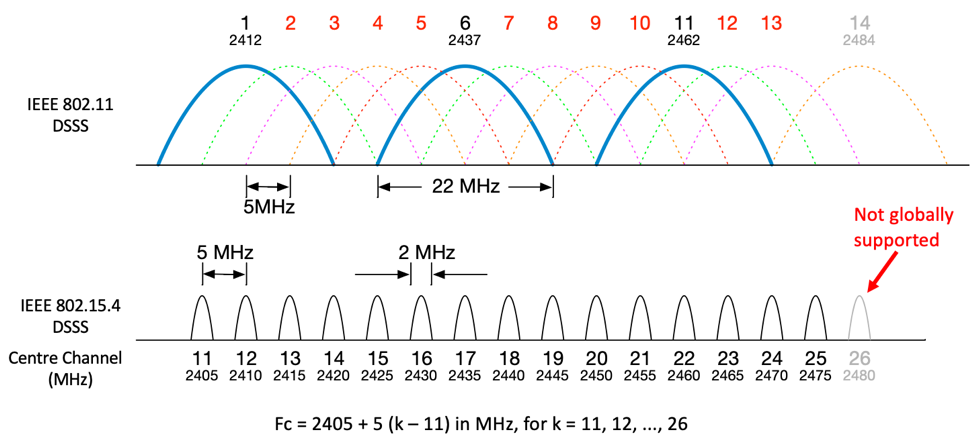WirelessHART Spectrum
WirelessHART is based on the IEEE 802.15.4-2006 standard – meaning specific flavours of the standard have been adopted by WirelessHART. This blog with address the channel and modulation characteristics defined in the IEEE 802.15.4-2006 standard and which features and combinations were specifically adopted by WirelessHART.
The 802.15.4 standard titled “Wireless Medium Access Control (MAC) and Physical Layer (PHY) Specifications for Low-Rate Wireless Personal Area Networks (WPANs)”. Most important to WirelessHART, the 2006 release added optional support for superframe structures – allowing a PAN coordinator to allocate timeslots to devices to transmitting and receiving.
Building on the 2003 standard, the 2006 release added two optional higher rate for lower frequency bands, as shown in the table below.
| Frequency | PHY | Modulation | Data Rate (kb/s) |
|---|---|---|---|
| 868/915 | DSSS | BPSK | 20 or 40 (optionally 100 to 250) |
| 868/915 | DSSS | O-QPSK | 20 or 40 (optionally 100 to 250) |
| 868/915 | PSSS | BPSK & ASK | 20 or 40 (optionally 100 to 250) |
| 2450 | DSSS | O-QPSK | 250 |
WirelessHART operates on the unlicensed 2.4GHz ISM band (2400 – 2483.5MHz). The 802.15.4 standard defines 27 channels numbered 0 through 26 within the 2.4GHz band. Pages are assigned to define which channel numbers are in used, what frequencies the channel numbers are applied to, what which modulations schemes are used. There are 32 channel pages defined, however only the first three (0 – 2) are used, while pages 3 through 31 are reserved for future use. WirelessHART uses page 0 as defined in Table 2 of the 802.15.4 standard, summarized in the table below:
| Channel Page (decimal) | Channel page (binary) (b31, b30, b29, b28, b27) | Channel number(s) (decimal) | Channel Number Description |
|---|---|---|---|
| 0 | 0 0 0 0 | 0 | Channel 0 – 868 MHz – BPSK |
| 0 | 0 0 0 0 | 1 – 10 | Channel 1 to 10 – 915 MHz – BPSK |
| 0 | 0 0 0 0 | 11 – 26 | Channel 11 to 26 – 915 MHz – BPSK |
Center frequencies for the 2.4GHz can be calculated using the following formula:
Fc = 2405 =5(k -11) in Megahertz, for k = 11, 12,…,26. (where k is the channel number).
From the equation above we know the center frequencies of each channel are spaced 5MHz apart. Additionally, the channel width is defined as 2MHz.

Based on the graph above we can see there are four IEEE 802.15.4 channels that fall in the guard bands between the three non-overlapping IEEE 802.11b channels (n = 15, 20, 25, 26 for North America;). ZigBee based networks will often settle on one of these four channels to avoid impact to and from nearby IEEE 802.11b/g/n networks.
The network manager assigns a channel hopping sequence for each node. Each transceiver hops on a per packet or per timeslot basis. Each timeslot has a fixed time period of 10ms which is long enough for a maximum size packet and the corresponding acknowledgment to be transmitted and received. The same channel is never repeated consecutively which increases the reliability of mesh network. It takes roughly 0.192 seconds to hop between channels.
Although 16 mutually orthogonal channels are supported by 802.15.4, only the first 15 channels are used by WirelessHART to maximize deploy ability across regional regulatory domains. Channel 26 is NOT used by WirelessHART.
Slàinte!